Tempted to recreate the artwork Phat Knits by Bauke Knottnerus that fascinated you in MoMu’s main hall during Unravel exhibition? We show you how it’s done.
Tempted to recreate the artwork Phat Knits by Bauke Knottnerus that fascinated you in MoMu’s main hall during Unravel exhibition? We show you how it’s done.
 On Saturday August 6th, Museumnacht invites you to spend a night at the museum. Sixteen Antwerp museums, including MoMu, open their doors from 7PM until 1AM and welcome you with performances, mini-concerts, cocktailbars and other special events. One ticket (from ‚ā¨1 for youngsters to ‚ā¨8 for those without reduction) gives you access to all participating museums. You can rent city bikes at Velo near the photo museum and diamond museum (from 6PM until 10PM) for the democratic price of ‚ā¨2 or use the free shuttle to move at your own ease between the different locations and make the most of it.
On Saturday August 6th, Museumnacht invites you to spend a night at the museum. Sixteen Antwerp museums, including MoMu, open their doors from 7PM until 1AM and welcome you with performances, mini-concerts, cocktailbars and other special events. One ticket (from ‚ā¨1 for youngsters to ‚ā¨8 for those without reduction) gives you access to all participating museums. You can rent city bikes at Velo near the photo museum and diamond museum (from 6PM until 10PM) for the democratic price of ‚ā¨2 or use the free shuttle to move at your own ease between the different locations and make the most of it.
And yes! MoMu knows how to live the nightlife. The fashion museum fulfills your appetite with delicious cupcakes for ‚ā¨2. The exciting Unravel exhibition will be open all night long with an extra selection of silhouettes, accessories and historical illustrations from the permanent collection tying in on the knitwear theme. An intense soundtrack by the young broadcasters of Kontakte will please your hanker for music with a full sound experience. Your visit to MoMu will open up all your senses for an unforgettable one-night-stand!
Don’t forget it’s one of your last chances to visit our Unravel exhibition!
A night at the museum
Saturday August 6th from 7PM
Presale at Info Cultuur, Grote Markt 13, Antwerpen
http://www.museumnacht.be
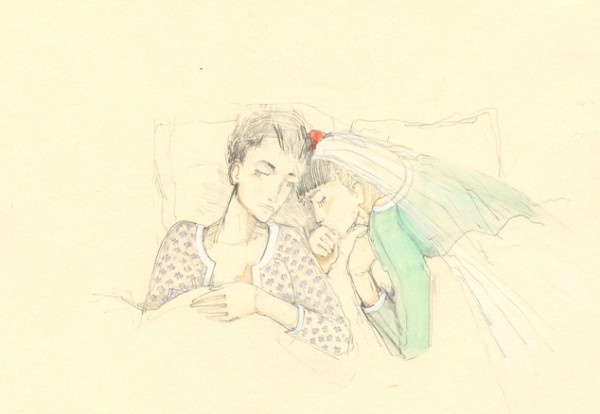 Each year the MoMu Fashion Museum presents a MoMu Award to a MA student at the Fashion Department of the Royal Academy in Antwerp. This award, to be presented during the jury proclamation in June, gives a single student the opportunity to present his or her collection in an exhibition at the MoMu Gallery. The MoMu Award is for a student whose course of study at the Royal Academy has been exceptionally motivating and whose work stands out in unique visual language. The recipient of the 2011 MoMu Award is Niels Peeraer. He presents his graduate collection Guess technology isn’t ready for pancake teleportation, consisting of couture-like tweed silhouettes, handmade leather armour, accessories and clothes, Japanese wooden sandals, all in candy-coloured pastels.
Each year the MoMu Fashion Museum presents a MoMu Award to a MA student at the Fashion Department of the Royal Academy in Antwerp. This award, to be presented during the jury proclamation in June, gives a single student the opportunity to present his or her collection in an exhibition at the MoMu Gallery. The MoMu Award is for a student whose course of study at the Royal Academy has been exceptionally motivating and whose work stands out in unique visual language. The recipient of the 2011 MoMu Award is Niels Peeraer. He presents his graduate collection Guess technology isn’t ready for pancake teleportation, consisting of couture-like tweed silhouettes, handmade leather armour, accessories and clothes, Japanese wooden sandals, all in candy-coloured pastels.
Niels Peeraer: “The collection is about a boy who has an imaginary boyfriend. Everyday, he prepares himself to get married. This, together with the love for his armour, videogames and his grandmother‚Äôs couture jackets, shapes his cute wardrobe. As the basis for my collection, I chose this diary entry from my main character, the silhouettes, graphic work and scenography for the MoMu gallery are based on this passage: ‚ÄúI‚Äôm confused, I‚Äôm sitting here on the sofa, the heart my boyfriend drew on the mirror is still there, my heart in a rice cooker. I think I‚Äôll marry him again at lunch. My cat is sleeping but it‚Äôs already been 4 days. Well, I have to go to the supermarket anyway. Guess technology isn‚Äôt ready for pancake teleportation‚ÄĚ.”
MOMU AWARD 2011 Niels Peeraer
Guess technology isn’t ready for pancake teleportation
From June 15th to August 14th at the MoMu Gallery
Free admission
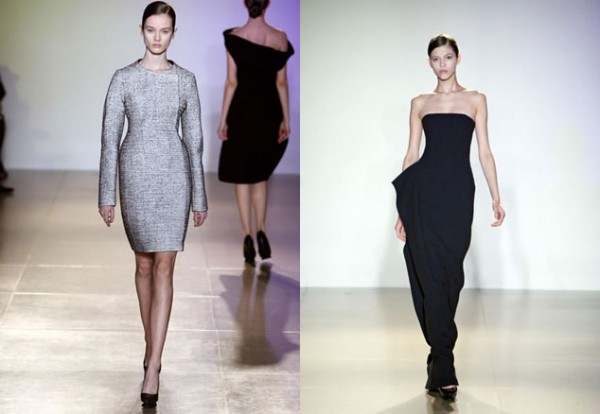
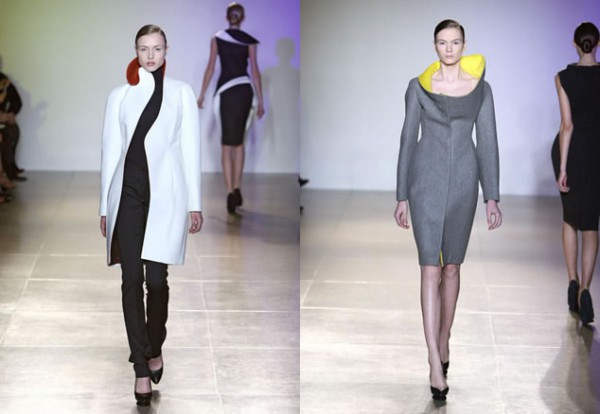 The collection department is pleased to announce the purchase of six key looks from Jil Sander‚Äės Autumn/Winter 2009/2010 collection ‚Äď under the creative direction of Raf Simons ‚Äď please refer to the pictures of four pieces from this purchase. This collection represented a remarkable signal of Raf Simons‚Äô new vision for Jil Sander.
The collection department is pleased to announce the purchase of six key looks from Jil Sander‚Äės Autumn/Winter 2009/2010 collection ‚Äď under the creative direction of Raf Simons ‚Äď please refer to the pictures of four pieces from this purchase. This collection represented a remarkable signal of Raf Simons‚Äô new vision for Jil Sander.
Simons combines two distinctive collections within one. The actual catwalk show established that divide: the first part was a result of an interesting research on Jil Sander‚Äôs archive in Hamburg, which no longer exists. Raf Simons very much respected the signature of straight-forward shapes characteristic of Jil Sander ‚Äď sharply tailored garments and linear silhouette suggesting modern practicality. However, the second ‚Äėchapter‚Äô of the story introduces Simon‚Äôs take on decorative arts. The Belgian designer moves on from the slick elegance of Jil Sander‚Äôs style to sculptural forms.
Simons takes inspiration from the works by the mid-century French sculptor-ceramicist Pol Chambost (1906-1983). Where again art influences fashion, Simons meets the voluptuous and curvy forms present in the modernist sculptures by Chambost. A stiff material ‚Äď similar to neoprene from wet suits ‚Äď was used to give structure to the garments highlighting raised and pronounced collars and twisted funnels around the neck and waistline, recreating the organic sculptural forms for dresses and coats. Shots of strong bright yellows and oranges, literally taken out from Chambost‚Äôs sculptures would appear in the monochromatic grey, white and navy-blue pieces.
Although the press and specialists then appeared a little sceptical about the complexity of the second part of this collection, describing it at times as a ‚Äėconcept‚Äô, Simons managed to create a visually impressive collection, where decorative arts is successfully interpreted and translated into clothing by a fashion designer.
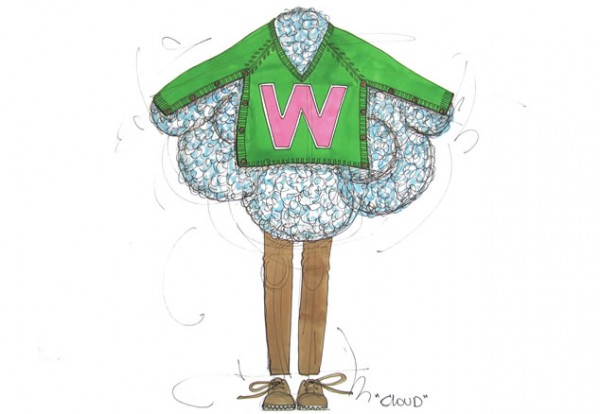 From May 29 to September 25, 2011, the Middelheim Museum will be a playground for contemporary artist Erwin Wurm. The Austrian artist will place 25 works among the pieces of the permanent collection. He is creating three new pieces for the Braem Pavilion. The exhibition Wear Me Out is a true voyage of discovery through the open-air museum, along which the visitor can wonder at Wurm’s expressive art, while at the same time becoming a part of it. Erwin Wurm has invited Antwerp fashion designer Walter Van Beirendonck to collaborate on a series of Performative Sculptures on May 28th at 4PM, August 6th at 8PM and September 25th at 4PM.
From May 29 to September 25, 2011, the Middelheim Museum will be a playground for contemporary artist Erwin Wurm. The Austrian artist will place 25 works among the pieces of the permanent collection. He is creating three new pieces for the Braem Pavilion. The exhibition Wear Me Out is a true voyage of discovery through the open-air museum, along which the visitor can wonder at Wurm’s expressive art, while at the same time becoming a part of it. Erwin Wurm has invited Antwerp fashion designer Walter Van Beirendonck to collaborate on a series of Performative Sculptures on May 28th at 4PM, August 6th at 8PM and September 25th at 4PM.
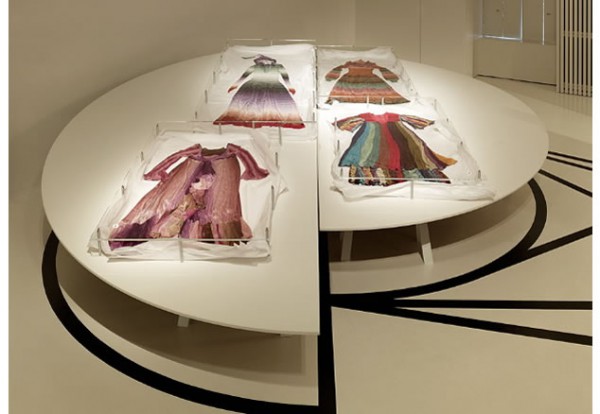 Although Antwerp enjoys the title of city of fashion in so many respects, people are not always aware of Antwerp’s connection with knitwear.
Although Antwerp enjoys the title of city of fashion in so many respects, people are not always aware of Antwerp’s connection with knitwear.
To introduce this new exhibition, MoMu has selected three Antwerp designers who have a special bond with knitwear. The installations can be seen as an homage to Ann Salens, the internationally renowned Antwerp designer from the 1970s, who won acclaim for her colourful crocheted ‚Äėbird of paradise dresses‚Äô, worn amongst others, by singer Ann Christy. Salens also created knit dresses that hug the shape of the body in a characteristic style.
Hilde Frunt & SIGI, the first designers to pay homage to Ann Salens, are mother and son who share a passion for knitwear. As a contemporary of Ann Salens during the 1970s, Hilde Frunt had her own shop on the Wolstraat in Antwerp, adjacent to that of Ann Salens. For this exhibition, Hilde Frunt and Sigi developed a ‚Äėknitted living room‚Äô setting, which emphasizes the intimate family atmosphere in which they both create knitwear. The installation is made up of three silhouettes and a range of interior items covered in their own particular style of knitwear.
Last to contribute is Christian Wijnants, who graduated in 2000 from the fashion department of the Royal Academy of Fine Arts in Antwerp. He already has 14 collections to his credit, each of which is in part made up of knitwear. He moreover passes on his passion for knitting to his students at the Antwerp Fashion Department, in his own specialty subject of knitwear. For this installation, Christian Wijnants made three mini-dresses in knitwear, employing an exceptional procedure that includes this favourite experiment: tie-dying knits.
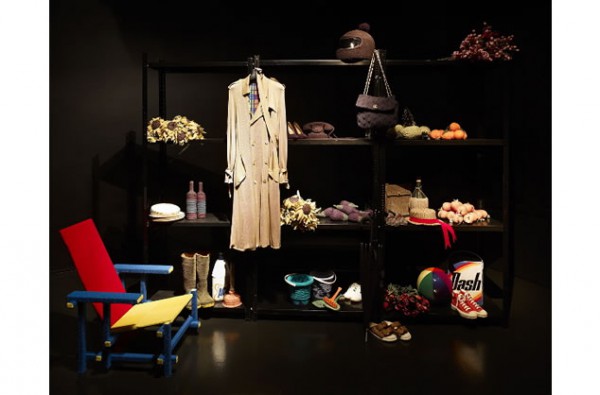 In 2004, Angelo Figus created this Supermarket of Style, with which he pinpointed fashion trends for 2006. His intention was to demonstrate a strong vision of a world in which everything was knitted. Figus creating knitted versions of various status symbols, ranging from knitted Hermès, Vuitton and Chanel handbags to Louboutin shoes and Burberry trench coats, even including Rietveld and Le Corbusier chairs and vegetables, fruits and flowers, all made of knitted fabric. In this supermarket full of knitted icons, you could literally live and eat from knitwear.
In 2004, Angelo Figus created this Supermarket of Style, with which he pinpointed fashion trends for 2006. His intention was to demonstrate a strong vision of a world in which everything was knitted. Figus creating knitted versions of various status symbols, ranging from knitted Hermès, Vuitton and Chanel handbags to Louboutin shoes and Burberry trench coats, even including Rietveld and Le Corbusier chairs and vegetables, fruits and flowers, all made of knitted fabric. In this supermarket full of knitted icons, you could literally live and eat from knitwear.
Angelo Figus’ preference for jersey has to do with its multisided character. Figus views knitting as an art, as well as a science, as a result of creating each piece by hand. Each step in the production process (the choice of threads, stitches or machines, etc…) produces a new result and turns knitwear into a highly personal means of participating in and reading fashion.
Although Bruno Pieters has taken a short break from showing his own collections at Paris Fashion Week, the Belgian designer is part of an interesting young generation of Antwerp designers. As MoMu recognises the uniqueness of this talent, the collection department accepted a donation of thirty pieces of varied collections by Pieters late last year. The highlights of this particular donation come from the Autumn/Winter 2009/2010 and Spring/Summer 2010 collections ‚Äď the latter can be appreciated in the video excerpt above.

From the geometric preciseness of the Autumn/Winter 2009/2010 collection, Pieters donated some of the metallic bronze and black little jackets and coats with square shoulders and austere construction ‚Äď an incredible exercise of tailoring that embodies a harsh and powerful silhouette for women. In contrast with the dark Winter 2010 collection, the Spring 2010 collection reveals a sheer lightness present in both textures and colours. The designer heavily explores feminine nude colours featuring mini dresses that look like a second natural skin, and though there is simplicity in the forms, attention to detail is evident as Pieters skilfully works with drapery and folding in those dresses. The quite spectacular and heavy‚Äďweight black crystal encrusted short dress with a low v split at the back, is shown on the catwalk as one of the main pieces from this season, and it is part of this donation to MoMu.

For those who would like to check the designer‚Äôs ability in working with knitwear, MoMu‚Äôs Unravel. Knitwear in Fashion, presents the exhibition visitor with two pieces by Pieters, from the donation to the collection department. The cotton-knitted sleeveless dress, originally from the Spring/Summer 2004 collection, makes reference to the use of natural fibres in knitting and it is incorporated into the sculptural knitwear section. The elaborately hand-knitted roll-neck jumper in open knitwear and embellished with ribbons (Autumn/Winter 2004/2005), is an authentic example of ‚Äėunravelling‚Äô knitwear and it is unveiled in the Unravel room of the exhibition.
MoMu and Bruno Pieters’ clientele are looking forward to seeing the come back of Pieters’ creative ideas translated into clothes that can be wearable yet with strong substantial content.
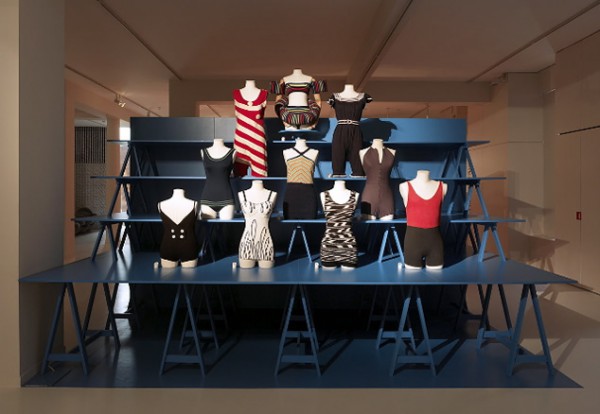
“Sports have freed women, and continue to free women, from restrictive dress, behavior, laws and customs ‚Äď and from the belief that women can‚Äôt or shouldn‚Äôt achieve or compete or win.” ‚ÄĒ Mariah Burton Nelson, 1998
The health movement and sporting lifestyle that began to develop at the beginning of the 20th century meant new clothing styles in the ‚Äėliving‚Äô fabric of preference: knitwear. Because of the way it fit the body and its breathability, knitted varieties, was universally praised as sportive materials.
The ‚Äėnew woman‚Äô took part in such outdoor sports as tennis, golf, hunting, skiing and climbing. Her wardrobe borrowed some elements from men‚Äôs sporting attire, but made theme more feminine. Designers such as Jean Patou and Gabrielle Chanel were visionary in their combinations of sportive woven fabrics and modern, fashionable designs for the emancipated woman. As a result, sports and fashion now became permanently linked.
Another iconic article of knitted clothing from the same period which deserves special attention is the bathing costume. Swimming became very popular among women. At the 1912 Olympic Games, women first took part in the swimming competitions. From then on, its popularity grew. This official Olympian seal of approval of swimming as an appropriate sport for women worked as a catalyst for the development of a modern and practical swimsuit. The Edwardian two-piece bathing costume was replaced in the 1920s by knitted, one-piece swimming suits of wool jersey and silk, reminiscent of earlier one-piece swimming costumes for men. The new swimsuits were infinitely more suitable for activities in the water than their historic predecessors.
As said by Jantzen, the American manufacturer: “The suit that changed bathing to swimming”.
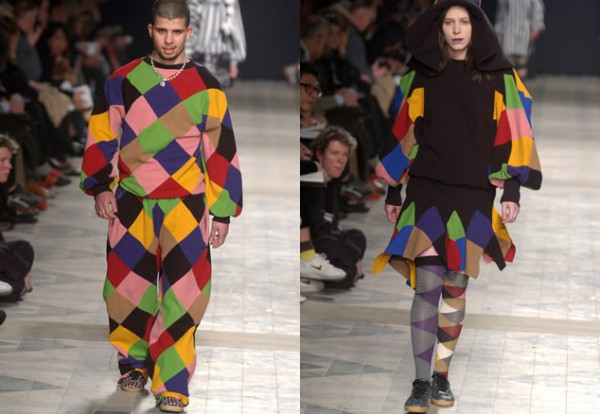
The central theme of this heritage day (Armoe Troef in Dutch, Poverty Stricken) can be interpreted in many different ways. MoMu chose to shed light on an age-old technique: patchwork. Everyone knows the multi-coloured bedcovers made of printed cottons in many different prints, that are often, and rightfully so, associated with rustic North America. But also in Europe, patchwork is part of a long tradition.
The origins of patchwork are hard to fathom, but generally, the idea is accepted that the mending of clothes was at its origin. On top of a hole or sign of usage, people sewed strips of cloth, and depending on the character and costliness of the piece of clothing, attention was given to the finishing of the borders and the choice of fabric. Also, the practice of imitating costly embroidery, by means of sewing of many different cut-out motifs on top of a base textile, is possibly at the origins of the patchwork technique. Clothing frugality , mostly because of the sparseness and costliness of clothes , but also the creative search for an economical way to make beautifully decorated textiles, played a part in the development of this technique.
In patchwork, a distinction is made between the sewing of pieces of fabric on a base cloth, the so-called appliqué technique, and the sewing together of pieces of cloths into a larger whole, mostly described as mosaic. Both for appliqué and mosaic, leftover pieces of garments were used. These leftovers were pieces that fell next to the pattern during the cutting of clothes or interior textiles, and which were recuperated this way. Worn garments were sometimes also cut up, but this happened rather in the higher classes, where clothes weren’t worn until they literally fell apart. By re-using textiles from garments, people honoured the memory of their beloved, or their memories from childhood. Mostly, during the nineteenth century, patchwork was a result of craftwork from women in the higher echelons of society, for whom the patchwork was a pastime, or from less wealthy women who worked on the patchwork for their own use or as a side-job.
Mosaic patchwork was primarily used to make bedcovers, which were lined and filled for warmth. To keep the filling in its proper place, the covers were stitched across, the so-called quilts. In the lavish interiors of the late 19th century, patchwork could also be found on poufs and used as decorative runners, like antimacassars. Appliqué was used as a decorative technique for clothing, but mosaic patchwork was rare. Fashionable clothing executed in mosaic patchwork can be found in the 1970s when the hippie culture reappropriated traditional handicrafts.
Ten years ago, at the start of the last decade, there was a remarkable presence of mosaic patchwork in the autumn/winter collections of a few Belgian and international designers. In Veronique Branquinho’s autumn/winter collection 2000/2001, the technique was applied to a pair of trousers and a velvet dress. Dirk Bikkembergs used the typical hexagonal pattern for a leather men’s jacket for his spring/summer collection 2002. A playful theme, frivolous and reminiscent of the harlequin, can be found in the menswear and womenswear collections of autumn-winter 2002/2003 by Bernhard Willhelm. In the same season, Nicolas Ghesquière created a few futuristic-looking dresses for Balenciaga , made of sewn-together strips of different sizes and forms in varying synthetic materials.
Heritage Day
Sunday May 1st, from 10AM to 6PM
http://www.erfgoeddag.be
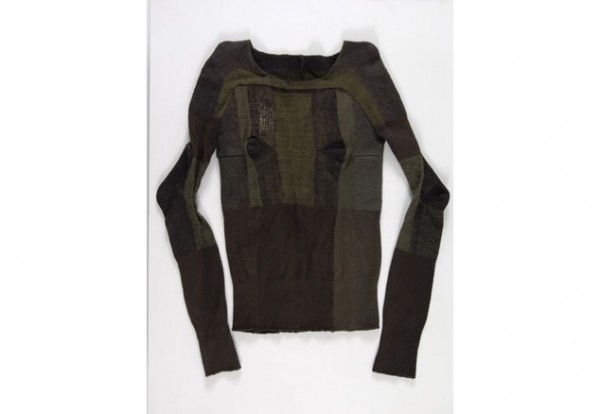 The nostalgia for wartime knitting inspired Martin Margiela‚Äės military sock sweater, a contemporary garment that owes much to the aesthetics of wartime austerity and also features in the Unravel. Knitwear in Fashion exhibition. Margiela‚Äôs sock sweater from the early 1990s reflects his fascination with deconstruction, but also celebrates wartime knitting as the ultimate do-it-yourself clothing project. However, his use of fashion to reference the role of knitting in war is achieved without sentimentality.
The nostalgia for wartime knitting inspired Martin Margiela‚Äės military sock sweater, a contemporary garment that owes much to the aesthetics of wartime austerity and also features in the Unravel. Knitwear in Fashion exhibition. Margiela‚Äôs sock sweater from the early 1990s reflects his fascination with deconstruction, but also celebrates wartime knitting as the ultimate do-it-yourself clothing project. However, his use of fashion to reference the role of knitting in war is achieved without sentimentality.
Neither does he think much of trade secrets, clear from his published instructions on how to ‚ÄėMake your own Margiela sweater‚Ķ‚Äô By referencing official instruction booklets on wartime knitting, Margiela shows an interest in the ways in which clothing becomes entangled in historical events. A clever comment on the status of socks as wartime comforts, the sock sweater reflects on how clothing became part of war experience.
A step-by-step guide to making your own version of the Margiela sock sweater also featured in A Magazine curated by Maison Martin Margiela in June 2004, which is also published online. (Scroll to pages 93 to 95.)
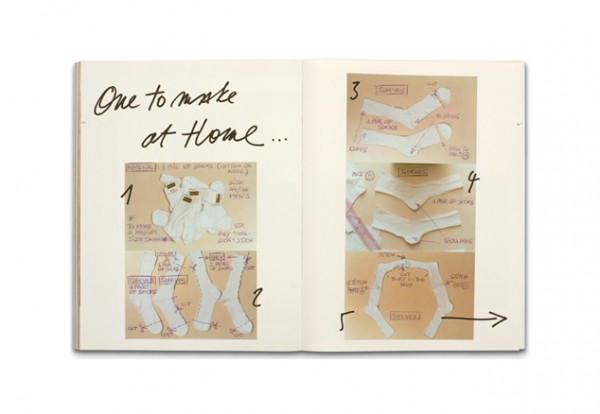
In our second clip on Unravel, MoMu talks to Swedish designer Sandra Backlund. Thanks to the Swedish Embassy in Brussels we were able to invite Sandra to come to Antwerp to be our guest for the opening vernissage.
Sandra talks about her love for knitwear, her link with Sweden and the silhouette worn by Tilda Swinton, which is the campaign image of the Unravel exhibition.